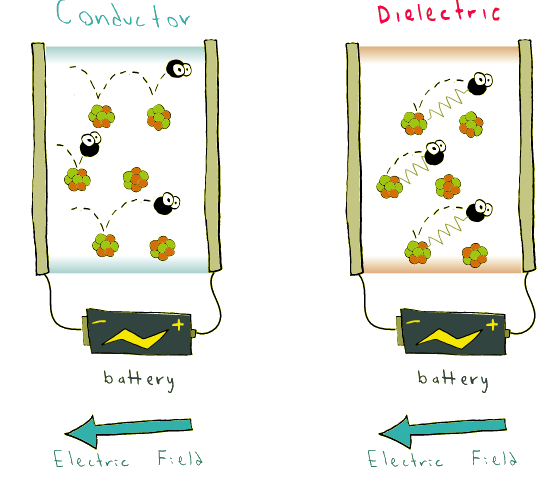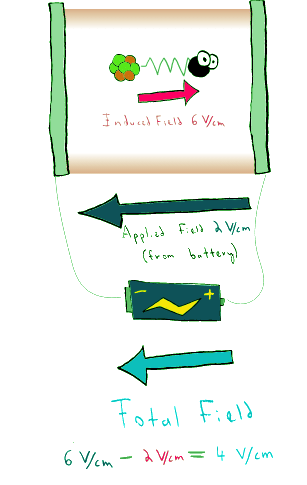Dielectrics | Physics for MCAT PDF Download
Introduction
Capacitors are essential components in various electronic devices, providing energy storage and power conditioning. One crucial aspect that affects their performance is the presence of dielectrics, which play a significant role in altering their properties. In this article, we will explore the concept of dielectrics, their impact on capacitors, and their intriguing connection to everyday phenomena such as lightning strikes.
What are Dielectrics?
Dielectrics, often referred to as insulators, are materials that hinder the flow of current. In contrast to conductors, dielectrics possess a unique property known as polarizability. This property is shared by all insulators and captures attention due to its intriguing characteristics.

The Role of Charges in Conductors and Dielectrics
When a battery is connected to a conductor, the potential difference between the battery's poles initiates the movement of charges within the conductor, resulting in a current flow. In conductors, the outer electrons are not bound to specific nuclei and can freely move throughout the material. However, in dielectrics, the charges are valence electrons firmly held within the atoms of a crystal or polymer, preventing current flow. Nevertheless, the electric field still exerts a force on these charges.
Understanding Polarization
In dielectrics, the charges, primarily valence electrons, exhibit a preference for the side of the atom closer to the positive terminal. Although these electrons seem eager to detach from their parent atoms, they remain bound due to electrostatic forces. This situation creates a balance between the electric field from the battery and the restoring force caused by the electrons' orbital motion around the nucleus.
Dielectric Breakdown
When a sufficiently large electric field is applied to a dielectric, the forces pushing the electrons can overcome the force that binds them to the atomic nucleus. This phenomenon, known as dielectric breakdown, results in the electrons being liberated from their leashes. Dielectric breakdown causes the dielectric to transition from being an insulator to a conductor. In practical capacitors, dielectric breakdown leads to sparks and damage.
Dielectric Influence on Capacitors
Capacitance Enhancement
The presence of a dielectric between the plates of a parallel-plate capacitor increases its total capacitance. The behavior of this enhancement can be predicted using the equation:
C_with_dielectric = k * C_without_dielectric
Here, C_with_dielectric represents the final capacitance, determined by the capacitor's size and shape, while C_without_dielectric denotes the capacitance without the dielectric. The dielectric constant, denoted as k, is a characteristic property of the specific dielectric used. It indicates the extent to which the capacitance increases when a particular dielectric is employed.

Common Dielectrics and Their Dielectric Constants
Various materials serve as dielectrics, each with its own dielectric constant. Some common dielectrics include wood (k = 2), beeswax (k = 4), glass (k = 5), and plastic (k = 5). The choice of dielectric material depends on factors such as cost, dielectric constant, and application requirements. In consumer electronics, plastic is commonly used due to its low cost and high dielectric constant, allowing for compact capacitor designs.
Electric Field Modification
The presence of a dielectric decreases the electric field within a capacitor by a factor equivalent to the dielectric constant. When the atoms in a dielectric polarize, they generate a field opposing the applied field, resulting in a reduced electric field within the capacitor.
Effect on Capacitor Properties
The alteration of the electric field due to dielectric insertion significantly affects the properties of capacitors. Since capacitors store energy within their electric fields, any modifications to the field influence the stored energy. For instance, if a capacitor charged to 6V has a dielectric with a dielectric constant of 3 inserted, the electric field decreases by a factor of 3, corresponding to a new capacitor voltage of 2V. This change also leads to a decrease in the energy stored by a factor of 3.
Dielectric Influence in Connected Capacitors
When a capacitor with a dielectric is connected to a fixed voltage source, such as a 6V battery, the voltage across the plates remains constant. In this scenario, the increase in capacitance caused by the dielectric insertion leads to a proportional increase in charge across the plates. Consequently, the energy stored in the capacitor increases by a factor equivalent to the change in capacitance.
Hair and Dielectric Effects during Lightning Strikes
During the threat of a lightning strike, a peculiar phenomenon occurs where all the hairs on an individual's head stand on end, creating an appearance akin to a giant puff ball. Interestingly, human hair acts as a dielectric in such situations.

Understanding the Mechanism
In the presence of lightning's high voltages, the conductive ground and the human body allow for charge flow. However, human hair, being an excellent insulator, experiences the same effect as the dielectric in a capacitor. The clouds, possessing a massive negative charge, act as one conducting plate, while the soggy ground below accumulates a large positive charge through induction, acting as the other plate. As charge builds up in the cloud, an electric field develops in the hair. The individual strands of hair, capable of independent movement, respond to the electric field and rise towards the clouds. Although the charges in the hair desire to complete the circuit and travel to the clouds, they remain tethered to the individual's head.
The Dynamics of Lightning Strikes
When a lightning strike occurs, it represents a dielectric breakdown, enabling current to flow through the air, the individual's hair, body, and into the ground. To avoid harm, it is crucial to seek shelter or move away from the affected area before this breakdown occurs.
Conclusion
Dielectrics play a vital role in capacitors by influencing their capacitance and altering the electric field within them. Understanding the behavior of dielectrics helps optimize capacitor design and functionality. Additionally, the intriguing connection between dielectrics and everyday phenomena, such as the hair standing on end during lightning strikes, adds a fascinating dimension to the study of dielectrics and their applications in electrical systems.
|
158 videos|21 docs|21 tests
|















